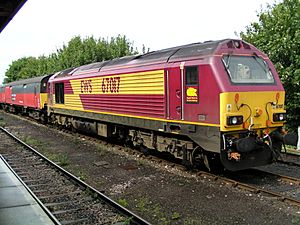British Rail Class 67 facts for kids
Quick facts for kids British Rail Class 67 |
|
 |
|
| 67017 'Arrow' at Plymouth | |
| Power type | Diesel-electric |
|---|---|
| Builder | Alstom, Spain for GM Electro-Motive Division |
| Model | JT42HW-HS |
| Build date | 1999–2000 |
| Total production | 30 |
| Configuration | Bo-Bo |
| UIC classification | Bo'Bo' |
| Gauge | 1,435 mm (4 ft 8 1⁄2 in) |
| Wheel diameter | 38 in (0.965 m) |
| Length | 19.71 m (64 ft 8 in) |
| Width | 2.71 m (8 ft 11 in) |
| Height | 3.93 m (12 ft 11 in) |
| Locomotive weight | 90 tonnes (88.6 long tons; 99.2 short tons) |
| Fuel capacity | 5,460 litres (1,200 imp gal; 1,440 US gal) |
| Prime mover | EMD 12N-710G3B-EC |
| Alternator | EMD AR9/HE3/CA6B |
| Traction motors | EMD D43FM |
| Multiple working | AAR system (Classes 59, 66 & 67) |
| Top speed | 125 mph (200 km/h) except 67007 which has cast iron brakes limited to 80 mph (130 km/h) |
| Power output | Engine: 2,980 bhp (2,220 kW) At rail: 2,500 hp (1,864 kW) |
| Tractive effort | Maximum: 31,750 lbf (141 kN) Continuous: 20,200 lbf (89.9 kN) |
| Train heating | Electric Train Supply (index: 66) |
| Locomotive brakeforce | 765 kN (76.8 long tons-force) |
| Train brakes | Air |
| Career | EWS |
| Number | 67001–67030 |
| Nicknames | ‘Skip’, 'Cyclops', 'Daddy Ying' |
| Axle load class | Route availability 8 |
The Class 67 is a special type of locomotive (a train engine) used in the UK. These powerful trains were built between 1999 and 2000. They were made in Spain by a company called Alstom, working with General Motors Diesel from Canada.
Contents
Meet the Class 67 Train
The Class 67 locomotives are a group of 30 powerful engines. They were designed to pull fast passenger trains. They also carried important mail services across the country. These trains are known for their speed and strength.
What Makes Them Special?
The Class 67 trains are diesel-electric locomotives. This means they use a diesel engine to create electricity. This electricity then powers motors that turn the wheels. It's a bit like a hybrid car, but much bigger!
Power and Speed
These trains are very fast. They can reach speeds of up to 125 mph (200 km/h). This made them perfect for express services. Each engine produces about 2,980 bhp (2,220 kW) of power. That's a lot of horse power for a train!
Cool Nicknames
Like many trains, the Class 67s have some fun nicknames. People sometimes call them 'Skip', 'Cyclops', or 'Daddy Ying'. These names often come from their unique look or sound.
What Do They Do?
Class 67 locomotives have been used for many different jobs. They are very versatile trains.
Carrying Mail and Passengers
When they were first built, many Class 67s were used for mail trains. They quickly moved letters and parcels around the UK. They also pulled passenger trains, especially on routes needing high speeds.
The Royal Train
Perhaps their most famous job is pulling the Royal Train. This special train carries members of the Royal Family. Two Class 67 locomotives, 67005 and 67006, are painted in a special royal livery (colour scheme) for this important duty.
Sleeper Trains and More
Class 67s have also pulled overnight sleeper trains. These trains let passengers sleep as they travel long distances. They are also used for moving empty passenger coaches. Sometimes, they even rescue other trains that have broken down.
Where Are They Now?
Today, many Class 67s are still in use. They continue to work for different railway companies. You might see them pulling special trains or on freight duties. They are a familiar sight on the UK railway network.
Images for kids
-
Royal Train livery (67005, King's Cross 2008)
-
67015 in Wrexham & Shropshire livery (Marylebone 2008)
-
Arriva livery (67003, Holyhead 2012)
-
Caledonian Sleeper livery (67004, Edinburgh Waverley 2015)
-
Colas Rail livery (67027, Derby 2017)











